This article was published in Scientific American’s former blog network and reflects the views of the author, not necessarily those of Scientific American
Some of you – maybe even most of you – will be familiar with All Yesterdays, a volume co-authored and co-illustrated by myself, John Conway, C. M. Kosemen and Scott Hartman (Conway et al. 2013). I’ve gotten a huge amount of mileage out of All Yesterdays.... I mean, an appropriate amount of mileage... and the project has been written about, and discussed, an awful lot. But our memories are short, and it’s now been four years since All Yesterdays was published: the sort of timespan in which we might expect some introspection or review.
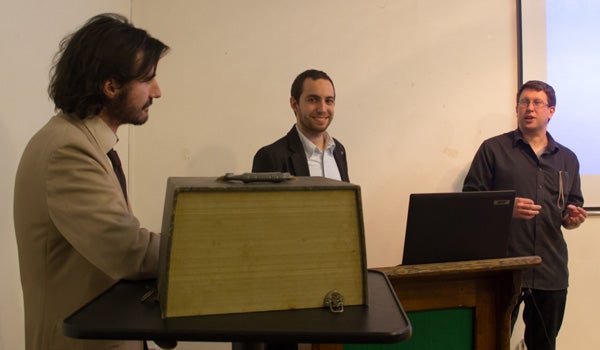
The people behind All Yesterdays, at a book launch in 2012. Left to right: Conway, Kosemen, Naish. Credit: Darren Naish
Back in 2013, Walking With Dinosaurs the movie was released, and for a while was accompanied by a website featuring articles penned by palaeontologists (predominantly by my occasional collaborator Steve Brusatte, I recall). That website has disappeared (for all intent and purposes: yes I do know about Wayback Machine and so on), so I think I’m within my rights to recycle the following article, published there and, until now, nowhere else.
On supporting science journalism
If you're enjoying this article, consider supporting our award-winning journalism by subscribing. By purchasing a subscription you are helping to ensure the future of impactful stories about the discoveries and ideas shaping our world today.
How reliable are life reconstructions of dinosaurs, pterosaurs and other fossil animals? Palaeontologists have given rather diverse answers on this question, with some saying that fossil animals can be reconstructed only approximately while others argue that well-preserved fossils allow the creation of high-fidelity, super-accurate renditions. Our knowledge of modern animal anatomy and the data we have on the bones, skin textures and proportions of fossil animals really do mean that some species can be reconstructed with a high degree of accuracy.
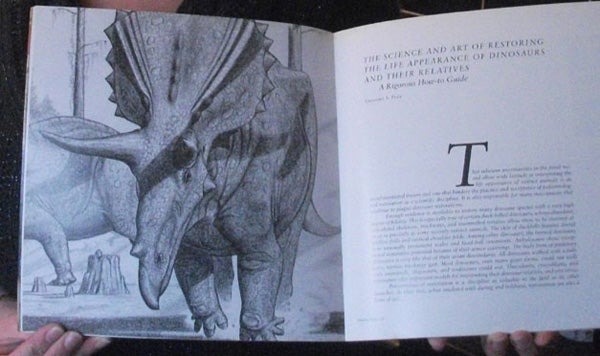
The opening pages from Greg Paul's 1987 article on the science and art of restoring extinct archosaurs. 1987 is a long time ago but this article is still a classic. Credit: Darren Naish
Today, artists who reconstruct fossil animals – we typically term these people palaeoartists – are supposed to understand the basics of bony and soft-tissue anatomy as well as the skeletal proportions of the animals they illustrate. The good ones do, and it shows.
Thanks predominantly to the anatomically rigorous skeletal reconstructions produced by American scientist and artist Greg Paul, palaeoartists have typically come to imagine dinosaurs and pterosaurs as skinny, lightweight animals with very little body fat. Feathery theropods and fuzzy ornithischians have been portrayed with only the minimal amount of covering such that their skeletal outline is still visible. At its most extreme, this trend has resulted in ‘zombie dinosaurs’ where every bone in the skeleton is visible in the live animal. This method of applying the minimal amount of soft tissue to a reconstruction has become known as shrink-wrapping.
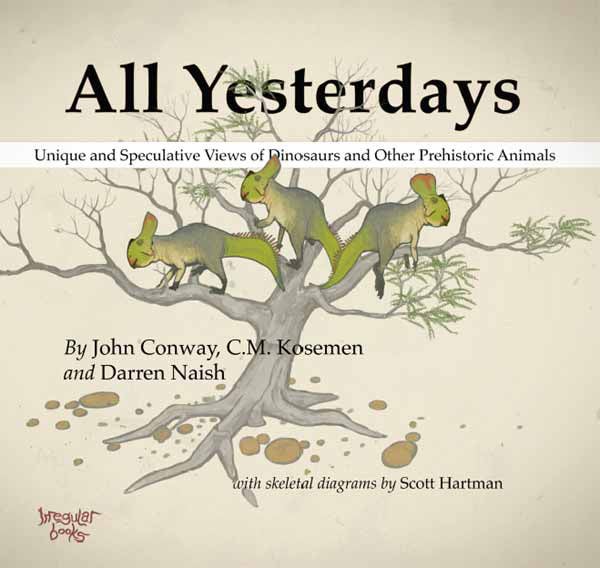
There aren't that many books out there that are dedicated to palaeoart, so it isn't difficult to obtain all of them. Whatever, All Yesterdays is arguably among the more important. Credit: Conway et al. 2012
As a fun thought experiment, what happens to living animals if we imagine them in the same way? Late in 2012, I and two of my artist colleagues (John Conway and C. M. Kosemen) did exactly this for our book All Yesterdays: Unique and Speculative Views of Dinosaurs and Other Prehistoric Animals. The shrink-wrapped hippos, baboons, whales and other animals included in All Yesterdays look utterly alien, and are of course absolutely unrealistic. Might we have made similar mistakes in reconstructing fossil animals?

If we apply shrink wrapping techniques to modern animals - if we pretend that we're non-mammalian palaeontologists from the future or something - we get some pretty outlandish results. Image by C. M. Kosemen, from All Yesterdays. Credit: Conway et al. 2012
At the minor end of things, a certain amount of leeway does exist with respect to how skinny, bulky, or muscular fossil animals were. A skinny T. rex with relatively small muscles might have looked slender and somewhat skeletal across much of its body, whereas one that had saved up large amounts of fat and built up large muscles might have looked chunky and rotund (cf. Hutchinson et al. 2011, Persons & Currie 2011). As with living animals, it’s entirely possible that individuals within a species varied this way according to age, sex, season and physical condition.
At the major end of things, we may (in cases) have significantly underestimated how fat and flabby some fossil animals were, how thick or fluffy their feathery or furry coasts were, or how flamboyantly decorated they were by soft frills, crests, or spines. Take feathered theropods. Fossils show that they did not have sparse scatterings of feathers on their necks and backs, as shown in shrink-wrapped reconstructions. Instead, they were clothed in dense feathery coats that must have mostly obscured their underlying skeletal form. Surprisingly long feathers obscured the contours of their limbs and tails, and feathers grew along their snouts and even to the tips of their toes.
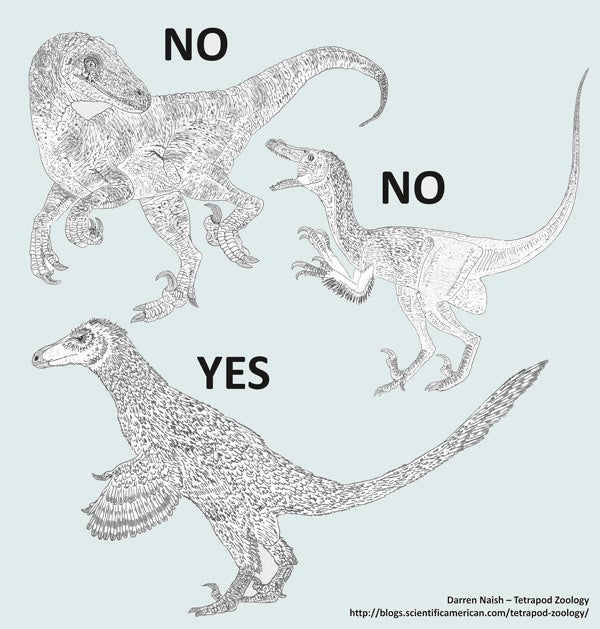
It's now technically incorrect to show maniraptoran theropods with no plumage or a sparse plumage: numerous fossils show that they were extensively covered in a complete plumage much like that of birds. The feathery dromaeosaur shown here is conservative in several respects. Credit: Darren Naish
Fuzz and quills preserved on the bodies of small ornithischians (e.g., Zheng et al. 2009, Godefroit et al. 2014) raise the very real possibility that the body shapes of these dinosaurs were similarly obscured by dense coverings of spines and quills.
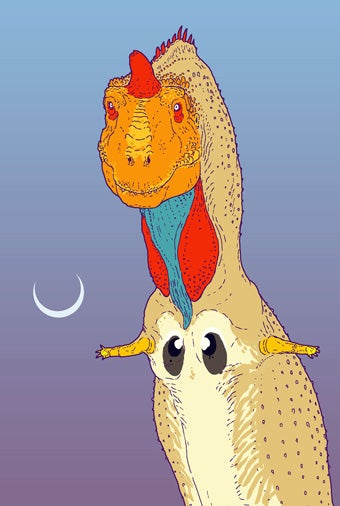
The possibility that some (or many) Mesozoic dinosaurs looked extravagant - even ridiculous - is very much within the realms of plausibility. This illustration from All Yesterdays, by C. K. Kosemen, depicts a displaying abelisaur. Lots of living animals are crazy and weird in appearance; we often don't realise because they're relatively familiar. Credit: Conway et al. 2012
In All Yesterdays we aimed to present dinosaurs and other Mesozoic animals with the same sort of soft tissue coverings that we see in living animals. We also experimented with the portrayal of behaviour, showing animals in unfamiliar and novel situations inspired by the behavioural diversity present in living species.
Rather than saying that these new reconstructions represent the way things really were, we offer them as alternatives to convention. There is much we can be confident about when reconstructing fossil animals – there are many important details that no proper palaeoartist has any business in getting wrong – but there is also a substantial amount that we simply cannot know, and perhaps never will.
More on dinosaur life appearance here soon. All Yesterdays can be purchased here from lulu.com. For previous Tet Zoo articles relevant to issues mention here, see...
The war on parasites: the pigeon’s eye view, the oviraptorosaur’s eye view
Junk in the trunk: why sauropod dinosaurs did not possess trunks (redux, 2012)
Artistic Depictions of Dinosaurs Have Undergone Two Revolutions
Refs - -
Godefroit, P., Sinitsa, S. M., Dhouailly, D., Bolotsky, Y. L., Sizov, A. V., McNamara, M. E., Benton, M. J. & Spagna, P. 2014. A Jurassic ornithischian dinosaur from Siberia with both feathers and scales. Science 345, 451-455.
Zheng, X.-T., You, H.-L, Xu, X. & Dong, Z.-M. 2009. An Early Cretaceous heterodontosaurid dinosaur with filamentous integumentary structures. Nature 458, 333-336.